Before children are large enough to be placed in booster seats, they typically are buckled into forward-facing restraint systems, also referred to as “harness seats” or “car seats.” Nearly all harness seats incorporate a five-point harness with straps that secure at the shoulders, across the upper thighs, and between the child’s legs. Most children then graduate to booster seats, which elevate a child so that a vehicle’s integrated lap and shoulder belt will fit safely and appropriately.
Many booster seat companies market their products as equally safe and appropriate as harness seats for children weighing as little as 30 pounds and as young as three. This marketing directly contradicts the recommendations of the National Highway Traffic Safety Administration and the American Academy of Pediatrics. Both state that children between three and seven should ride in a harness seat until they reach the top height or weight limit allowed by the manufacturer and outgrow the harness seat. Manufacturers market booster seats to parents whose children are too young to safely travel in one, increasing the risk of serious injury.
Harness seats provide additional protection that booster seats do not. By using shoulder and crotch straps rather than a seat belt to secure the child, harness seats reduce injury by spreading crash forces over a wider area of the child’s body. They also remove the risk that the seat belt will move to a dangerous position – such as across the child’s neck or behind the shoulders – at or prior to impact. Unlike booster seats, harness seats crotch straps help keep a child from sliding under the lap belt during an accident, particularly younger children whose pelvic bones are still developing the bony ridges that help anchor them to the seat.
Booster seats undergo inadequate safety testing before reaching the market. They are held to the same standard as harness seats, which is problematic because booster seats and harness seats restrain children in very different ways. At no time are booster seats tested to ensure that a vehicle’s lap and shoulder belt is in the correct position. Companies do not test – and do not know – the safety performance of booster seats for children who weigh 30-35 lbs. No booster seat company has developed its own testing standards to ensure its seats are safe. As booster seats companies continue to market their products in contravention of safety industry recommendations, young children are being moved prematurely into booster seats – heightening their risk for increased injuries in a crash.
Booster seat manufacturers are needlessly putting children at risk and must be held accountable for their actions. If your child has been injured in an automobile collision, contact the trial attorneys at Rapoport Law Offices for a free consultation on how to protect your child’s legal rights.

The Legal Examiner and our Affiliate Network strive to be the place you look to for news, context, and more, wherever your life intersects with the law.













Comments for this article are closed.